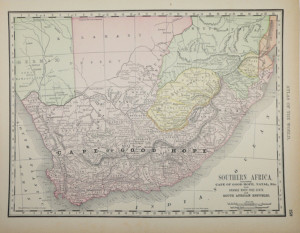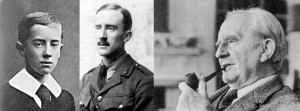If you were born on January 3, then you share your birthday with literary legend J.R.R. Tolkien. As the hobbits of Hobbiton might have said, today would have been his twelvety-fourth birthday.
Tolkien was born on this day in 1892 in what is now South Africa. The map of the area was quite a bit different then than it is now, and the nation of his birth then was called Orange River Free State, and lay northwest of the mountains of present day Lesotho. In fact, the South African state is still called Free State—a political and cartographic legacy of those days of political upheaval and change.

At the age of three, Tolkien was moved to England with his mother and brother. Later, he would spend time on the farm of Jane Neave, his aunt. The name of the farm was (and still is) Bag End Farm, and was the inspiration and namesake of location in The Hobbit. Bag End Farm was located west of Stratford-upon-Avon, UK (the birthplace of Shakespeare) in Dormston. Darmston is little more that a quaint, rural hamlet that boast the lush, idyllic landscape that came to appear in his most famous works. Author Andrew Morton notes,
“Jane had done her research; having sifted through the deeds, it was she who discovered that the charmingly English name Bag End was the original, and, according to locals, proper name of her farm. It may even be that the words ‘Bag End’ and his recently discovered Yorshire dialect word ‘baggins’ started to from an alliance in his linguistic imagination.”
It looks as if Bilbo Baggins might have gotten his name form the name of a farmstead as spoken in a thick, rural Yorkshire accent.
Tolkien was a gifted linguist, and was exposed to interesting languages early on. In addition to the panoply of dialects around him in England, he was exposed to constructed languages. Constructed languages are made-up language, but they are not mere babble like “speaking in tongues”; rather, they are designed and assembled with a specific vocabulary and grammar. Often the vocabulary is small and the grammar is simplistic for practical reasons, but this need not be so. Tolkien created his own languages after an encounter with Animalic, created by two cousins in the midst of the study of classical languages. Naffarin was the first constructed language to be his own creation. In later years, he would construct an impressive array of languages for use in his stories: Elvish (Primitive Quendian, Common Eldarin, Quenya, Goldogrin, Noldorin, Telerin, Ilkorin, Doriathrin, Avarin, and Sindarin), Rohirric, Haladin, Dunlendish, Drûg, Haradrim, Adûnaic, Easterling, and Valarin, which he divided into three branches: Oromëan, Aulëan, and Melkian. Most of these languages were developed from Tolkien’s own exposure to Germanic tongues such as Anglo-Saxon (now Old English), Gothic, and Old Norse, which are rich in linguistic complexities and still confound and frustrate learners today.
Tolkien served in World War I as a Lieutenant (officers were routinely drawn from the upper class, while the trenches were similarly routinely filled with the social dross of the labor class). After only a few months in the field, Tolkien had lost a number of close friends in battle, and eventually fell ill to a louse-vectored illness and sent home to England to recuperate. Soon after his departure, his battalion suffered catastrophic losses in personnel and materiel. Said Tolkien in the preface of the second edition of The Lord of the Rings:
“By 1918 all but one of my close friends were dead.”
Tolkien would use these horrific experiences to inform the hardships of battle laid out in his epics.

Tolkien remained in the military until 1920, and then began a civilian career, eventually becoming the youngest professor at the University of Leeds where he made translations of important Anglo-Saxon classics, including Beowulf, which took six years to complete and was not published until 88 years later in 2014 (posthumously by his son, Christopher). In 1925 he moved on to Pembroke College, a constituent college of Oxford (and not to be confused with the Cambridge constituent by the same name), where he began to write his magnus opus, completing The Hobbit, The Fellowship of the Ring, and The Two Towers. He did not complete The Return of the King until 1948.
J.R.R. Tolkien died on September 2, 1973. On the tombstone he shares with his wife of 55 years, Edith, he had applied the epithets Lúthien and Beren, drawn from his Legendarium, a reference to eternal love and sacrifice for its sake.
Resources:
J.R.R. Tolkien, Wikipedia
South Africa Map 1892 […], OldMapsAndPrints (Etsy Store)
Bag End—A Very English Place, Tolkien Library, Morton, Andrew H.
Tolkien’s Bag End, Morton, Andrew H.
Dormston and Bag End, Moore, Robert
Languages Constructed by JRR Tolkien, Wikipedia
Battle of the Somme, Wikipedia